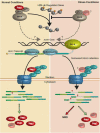Regulated pre-mRNA splicing: the ghostwriter of the eukaryotic genome
- PMID: 22248620
- PMCID: PMC3345063
- DOI: 10.1016/j.bbagrm.2011.12.011
Regulated pre-mRNA splicing: the ghostwriter of the eukaryotic genome
Abstract
Intron removal is at the heart of mRNA synthesis. It is mediated by one of the cell's largest complexes, the spliceosome. Yet, the fundamental chemistry involved is simple. In this review we will address how the spliceosome acts in diverse ways to optimize gene expression in order to meet the cell's needs. This is done largely by regulating the splicing of key transcripts encoding products that control gene expression pathways. This widespread role is evident even in the yeast Saccharomyces cerevisiae, where many introns appear to have been lost; yet how this control is being achieved is known only in a few cases. Here we explore the relevant examples and posit hypotheses whereby regulated splicing fine-tunes gene expression pathways to maintain cell homeostasis. This article is part of a Special Issue entitled: Nuclear Transport and RNA Processing.
Copyright © 2012 Elsevier B.V. All rights reserved.
Figures



Similar articles
-
Mechanisms and regulation of spliceosome-mediated pre-mRNA splicing in Saccharomyces cerevisiae.Wiley Interdiscip Rev RNA. 2024 Jul-Aug;15(4):e1866. doi: 10.1002/wrna.1866. Wiley Interdiscip Rev RNA. 2024. PMID: 38972853 Free PMC article. Review.
-
Genome-wide analysis of pre-mRNA splicing: intron features govern the requirement for the second-step factor, Prp17 in Saccharomyces cerevisiae and Schizosaccharomyces pombe.J Biol Chem. 2004 Dec 10;279(50):52437-46. doi: 10.1074/jbc.M408815200. Epub 2004 Sep 27. J Biol Chem. 2004. PMID: 15452114
-
RNAse III-mediated degradation of unspliced pre-mRNAs and lariat introns.Mol Cell. 2003 May;11(5):1279-89. doi: 10.1016/s1097-2765(03)00137-0. Mol Cell. 2003. PMID: 12769851
-
Splicing of precursors to mRNA in higher plants: mechanism, regulation and sub-nuclear organisation of the spliceosomal machinery.Plant Mol Biol. 1996 Oct;32(1-2):1-41. doi: 10.1007/BF00039375. Plant Mol Biol. 1996. PMID: 8980472 Review.
-
A subset of Mer1p-dependent introns requires Bud13p for splicing activation and nuclear retention.RNA. 2006 Jul;12(7):1361-72. doi: 10.1261/rna.2276806. Epub 2006 May 31. RNA. 2006. PMID: 16738408 Free PMC article.
Cited by
-
Role of pseudoexons and pseudointrons in human cancer.Int J Cell Biol. 2013;2013:810572. doi: 10.1155/2013/810572. Epub 2013 Sep 24. Int J Cell Biol. 2013. PMID: 24204383 Free PMC article. Review.
-
Review of the Genetic Basis of Jaw Malformations.J Pediatr Genet. 2016 Dec;5(4):209-219. doi: 10.1055/s-0036-1593505. Epub 2016 Oct 12. J Pediatr Genet. 2016. PMID: 27895973 Free PMC article. Review.
-
Dedicated chaperones coordinate co-translational regulation of ribosomal protein production with ribosome assembly to preserve proteostasis.Elife. 2022 Mar 31;11:e74255. doi: 10.7554/eLife.74255. Elife. 2022. PMID: 35357307 Free PMC article.
-
Haploinsufficiency of SF3B4, a component of the pre-mRNA spliceosomal complex, causes Nager syndrome.Am J Hum Genet. 2012 May 4;90(5):925-33. doi: 10.1016/j.ajhg.2012.04.004. Epub 2012 Apr 26. Am J Hum Genet. 2012. PMID: 22541558 Free PMC article.
-
Excess of Yra1 RNA-Binding Factor Causes Transcription-Dependent Genome Instability, Replication Impairment and Telomere Shortening.PLoS Genet. 2016 Apr 1;12(4):e1005966. doi: 10.1371/journal.pgen.1005966. eCollection 2016 Apr. PLoS Genet. 2016. PMID: 27035147 Free PMC article.
References
-
- Nilsen TW. The spliceosome: the most complex macromolecular machine in the cell? Bioessays. 2003;25:1147–1149. - PubMed
-
- Will CLL. R. . Spliceosome structure and function. In: Gesteland RF, Cech TR, Atkins JF, editors. The RNA World. Third Edition Cold Spring Harbor Laboratory Press; Cold Spring Harbor, NY: 2006. pp. 369–400.
-
- Du H, Rosbash M. The U1 snRNP protein U1C recognizes the 5' splice site in the absence of base pairing. Nature. 2002;419:86–90. - PubMed
-
- Berget SM. Exon recognition in vertebrate splicing. J Biol Chem. 1995;270:2411–2414. - PubMed
-
- Lallena MJ, Chalmers KJ, Llamazares S, Lamond AI, Valcarcel J. Splicing regulation at the second catalytic step by Sex-lethal involves 3' splice site recognition by SPF45. Cell. 2002;109:285–296. - PubMed
Publication types
MeSH terms
Substances
Grants and funding
LinkOut - more resources
Full Text Sources
Molecular Biology Databases

